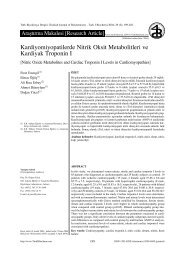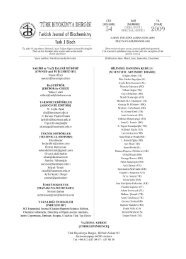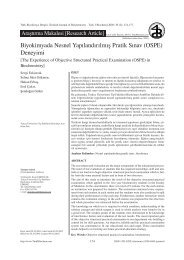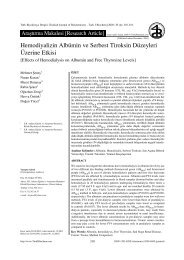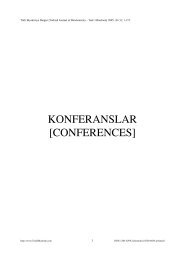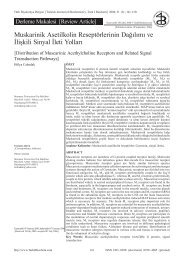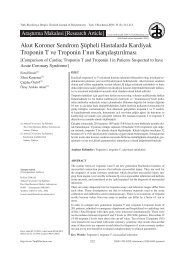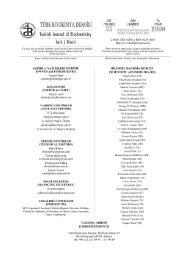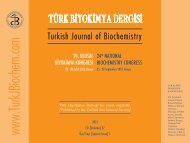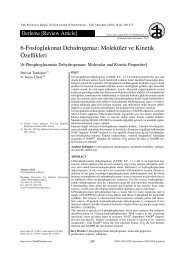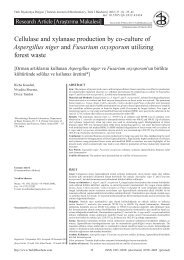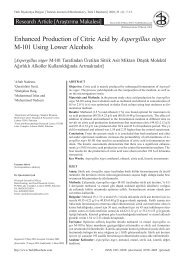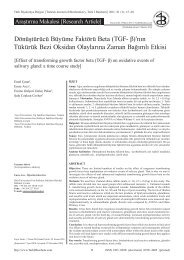23. Ulusal Biyokimya Kongresi Ãzel Sayısı - Türk Biyokimya Dergisi
23. Ulusal Biyokimya Kongresi Ãzel Sayısı - Türk Biyokimya Dergisi
23. Ulusal Biyokimya Kongresi Ãzel Sayısı - Türk Biyokimya Dergisi
Create successful ePaper yourself
Turn your PDF publications into a flip-book with our unique Google optimized e-Paper software.
XXIII. ULUSAL B‹YOK‹MYA KONGRES‹<br />
29 Kasım - 2 Aralık 2011<br />
Hilton Hotel - Adana<br />
<strong>23.</strong> <strong>Ulusal</strong> <strong>Biyokimya</strong> <strong>Kongresi</strong>, Adana [23 rd National Biochemistry Congress, Adana / TURKEY]<br />
İÇİNDEKİLER<br />
KANSERDE ENERJİ METABOLİZMASI DEĞİŞİMLERİ<br />
Hakan BOYUNAĞA<br />
Kırıkkale Üniversitesi, Tıp Fakültesi, Tıbbi <strong>Biyokimya</strong> Anabilim Dalı, Kırıkkale /<br />
Türkiye<br />
hboyunaga2000@yahoo.com<br />
ENERGY METABOLISM CHANGES IN CANCER<br />
Hakan BOYUNAĞA<br />
Department of Medical Biochemistry, Faculty of Medicine Kırıkkale<br />
University, Kırıkkale / Turkey<br />
hboyunaga2000@yahoo.com<br />
CONTENTS<br />
DAVETLİ KONUŞMACI ÖZETLERİ<br />
Karsinogenez; birçok faktöre bağlı olarak gelişen, öncelikle genetik, ardından da<br />
enerji metabolizması değişimleri ile kendini gösteren kompleks bir süreçtir. Bu<br />
süreçte kanser hücresi, artmış olan protein sentezi ve hücre bölünmesi için çok<br />
fazla substrata ve yüksek metabolizma hızına ihtiyaç duyar.<br />
Kanser hücreleri ya da köken aldıkları sağlıklı hücreler enerji temininde temelde<br />
benzer substratları ve benzer metabolik yolları kullanmaktadırlar. Bahsedilen<br />
substrat ve temel enerji temin yolları aynı olmasına rağmen sağlıklı ve kanserleşmiş<br />
hücrelerdeki temel farklılık, enerji temininde kullanılan metabolik yollarda değil<br />
bu yolların kullanım oranlarında izlenmektedir.<br />
Karsinogenezde İzlenen Metabolizma Oranlarındaki Değişimlerin Moleküler<br />
Mekanizması: Karsinogenez sürecinde izlenen genetik değişimlerin bir sonucu<br />
olarak kanser hücresinde bazı metabolik değişimler tanımlanmıştır. Bunların<br />
başlıcaları; Warburg etkisi, Pasteur etkisi ve Crabtree etkisidir. Bu etkilerin<br />
genel bir sonucu olarak hücre artmış olan enerji ihtiyacını, esas olarak anaerobik<br />
glikolizi kullanarak gerçekleştirmektedir.<br />
Warburg Etkisi: Otto Warburg, solit tümörlerin köken aldıkları sağlıklı dokulara<br />
göre çok büyük oranda anaerobik glikolizi kullandıklarını ve bunun sonucu olarak<br />
üretilen laktik asitin hücre pH’ını asiditiye kaydırdığını bildirmiştir.<br />
Pasteur Etkisi: Sağlıklı hücrelerde ve bazı tümörlerde ortamın oksijen<br />
konsantrasyonu düştüğünde, aerobik yolun anaerobik yola kanalize olmasıdır.<br />
Buna bağlı substrat tüketimi ve laktat üretimi artar. Ortalama 5,6-7,6 arasına inen<br />
pH değeri bir çok mekanizmanın tetiklenmesine neden olmaktadır. Bunlar;<br />
Oksijen tutulumunun azalması: Alkali solüsyonlar oksijeni absorbe edebilirken,<br />
pH 7’nin altına indiğinde ortamdan oksijen uzaklaştırılır.<br />
Laktat Dehidrogenaz miktarının arttırılması: Onkogenik bir transkripsiyon<br />
faktörü olan c-myc’in Hipoksi Induicibe Faktör-1 (HIF-1) ile beraber, Laktat<br />
Dehidrogenazı 30-43 kat arttırmaktadır.<br />
Crabtree Etkisi: Crabtree etkisi; yüksek proliferasyon hızına sahip hücrelerde<br />
(kanserler, bazı bakteri ve paraziter hücrelerde) görülmektedir. Ortamın substrat<br />
konsantrasyonunun bol olduğu durumlarda, kanserleşen hücreler, enerjilerini<br />
anaerobik glikolizle karşılamaktadırlar.<br />
Carcinogenesis develops due to many factors, primarily genetic and is a complex process<br />
characterized by changes in energy metabolism. In this process cancer cell needs so many<br />
substrate and high metabolic rate for increased protein synthesis and cell division.<br />
Cancer cells or originated healthy precursors use similar metabolic ways and substrates<br />
for maintaining energy. When compared energy metabolisms of the cells in the way of<br />
carcinogenesis and their root cells, it is seen that basic difference is not at the metabolic<br />
pathways but at the percentage of these pathways.<br />
Molecular mechanism of metabolism change rates in carcinogenesis: Some metabolic<br />
changes were described in the cancer cell as a result of genetic changes observed in the<br />
process of carcinogenesis. The main of them are Warburg, Pasteur and Crabtree effects.<br />
The cancer cell maintains energy need especially by the way of anaerobic glycolysis as a<br />
general result of these effects.<br />
Warburg Effect: Otto Warburg has stated that solid tumors use mainly anaerobic glycolysis<br />
according to their originated healthy tissue, and as a result of this, produced lactic asid<br />
shifts cell PH to asidity.<br />
Pasteur Effect: Pasteur Effect is the change of the aerobic pathway to the anaerobic<br />
pathway when ambient oxygen concentration decreased in healthy cells and in some<br />
tumors. Accordingly, substrate consumption and lactate production increases. Decreased<br />
PH value of 5.6-7.6 gives reason to trigger a lot of mechanism. These:<br />
Decreased oxigen uptake: Alkaline solutions can absorb oxigen but when PH decreased to<br />
the level below 7, oxigen is taken away form the envirement.<br />
Increased lactate dehydrogenase: C-myc that is an oncogenic transcription factor and<br />
hypoxy inducible factor-1 (HIF-1) increases lactate dehydrogenase 30-43 times.<br />
Crabtree Effect: Crabtree effect is observed in cells having high proliferation rate (cancers,<br />
cells, some bacteria and parasites). Cancer cells provide their energy by the way of anaerobic<br />
glycolysis when the substrate concentration of the media is plenty.<br />
Our energy metabolism studies of different tumors, Our results and Metabolic Index: In<br />
relation to Cancer cells that having metabolic preference, we studied energy metabolisms<br />
of polymorphonuclear leukocytes obtained from cell cultures of HL-60, Multiple<br />
Myeloma, MCF-7 and from patients with CLL and CML. We observed ATP production<br />
is obtained mainly by anaerobic glycolysis, and also observed different rates of Pasteur,<br />
ABSTRACTS OF INVITED LECTURES<br />
Turk J Biochem, 2011; 36 (S2)<br />
http://www.TurkJBiochem.com



